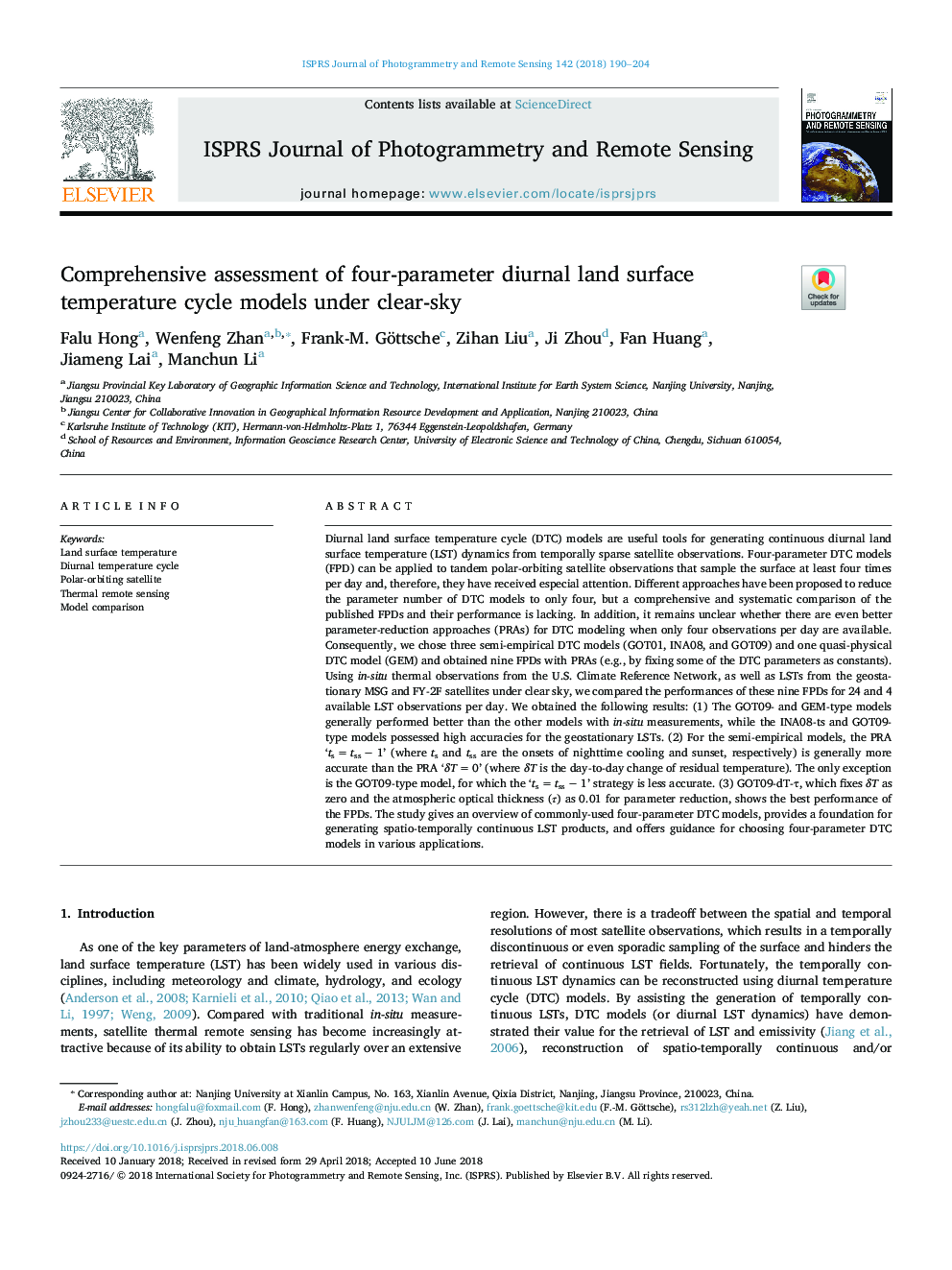| کد مقاله | کد نشریه | سال انتشار | مقاله انگلیسی | نسخه تمام متن |
|---|---|---|---|---|
| 6949085 | 1451232 | 2018 | 15 صفحه PDF | دانلود رایگان |
عنوان انگلیسی مقاله ISI
Comprehensive assessment of four-parameter diurnal land surface temperature cycle models under clear-sky
ترجمه فارسی عنوان
ارزیابی جامع مدل های چرخه دمای سطح زمین روزانه چهار پارامتر تحت نور آبی
دانلود مقاله + سفارش ترجمه
دانلود مقاله ISI انگلیسی
رایگان برای ایرانیان
کلمات کلیدی
دمای سطح زمین، چرخه دمای روزانه، ماهواره قطبی قطبی، سنجش از راه دور حرارتی، مقایسه مدل،
موضوعات مرتبط
مهندسی و علوم پایه
مهندسی کامپیوتر
سیستم های اطلاعاتی
چکیده انگلیسی
Diurnal land surface temperature cycle (DTC) models are useful tools for generating continuous diurnal land surface temperature (LST) dynamics from temporally sparse satellite observations. Four-parameter DTC models (FPD) can be applied to tandem polar-orbiting satellite observations that sample the surface at least four times per day and, therefore, they have received especial attention. Different approaches have been proposed to reduce the parameter number of DTC models to only four, but a comprehensive and systematic comparison of the published FPDs and their performance is lacking. In addition, it remains unclear whether there are even better parameter-reduction approaches (PRAs) for DTC modeling when only four observations per day are available. Consequently, we chose three semi-empirical DTC models (GOT01, INA08, and GOT09) and one quasi-physical DTC model (GEM) and obtained nine FPDs with PRAs (e.g., by fixing some of the DTC parameters as constants). Using in-situ thermal observations from the U.S. Climate Reference Network, as well as LSTs from the geostationary MSG and FY-2F satellites under clear sky, we compared the performances of these nine FPDs for 24 and 4 available LST observations per day. We obtained the following results: (1) The GOT09- and GEM-type models generally performed better than the other models with in-situ measurements, while the INA08-ts and GOT09-type models possessed high accuracies for the geostationary LSTs. (2) For the semi-empirical models, the PRA 'tsâ¯=â¯tssâ¯ââ¯1' (where ts and tss are the onsets of nighttime cooling and sunset, respectively) is generally more accurate than the PRA 'δTâ¯=â¯0' (where δT is the day-to-day change of residual temperature). The only exception is the GOT09-type model, for which the 'tsâ¯=â¯tssâ¯ââ¯1' strategy is less accurate. (3) GOT09-dT-Ï, which fixes δT as zero and the atmospheric optical thickness (Ï) as 0.01 for parameter reduction, shows the best performance of the FPDs. The study gives an overview of commonly-used four-parameter DTC models, provides a foundation for generating spatio-temporally continuous LST products, and offers guidance for choosing four-parameter DTC models in various applications.
ناشر
Database: Elsevier - ScienceDirect (ساینس دایرکت)
Journal: ISPRS Journal of Photogrammetry and Remote Sensing - Volume 142, August 2018, Pages 190-204
Journal: ISPRS Journal of Photogrammetry and Remote Sensing - Volume 142, August 2018, Pages 190-204
نویسندگان
Falu Hong, Wenfeng Zhan, Frank-M. Göttsche, Zihan Liu, Ji Zhou, Fan Huang, Jiameng Lai, Manchun Li,
